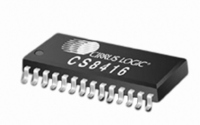CS8416-CNZ Cirrus Logic Inc, CS8416-CNZ Datasheet - Page 49

CS8416-CNZ
Manufacturer Part Number
CS8416-CNZ
Description
IC RCVR DGTL 192KHZ 28QFN COMM
Manufacturer
Cirrus Logic Inc
Type
Digital Audio Interface Receiverr
Datasheet
1.CS8416-CZZ.pdf
(60 pages)
Specifications of CS8416-CNZ
Applications
Digital Audio
Mounting Type
Surface Mount
Package / Case
28-QFN
Audio Control Type
Digital
Control Interface
I2C, SPI
Control / Process Application
AV & DVD Receivers, CD-R, Digital Mixing Consoles
Supply Voltage Range
3.13V To 5.25V, 3.13V To 3.46V
Lead Free Status / RoHS Status
Lead free / RoHS Compliant
For Use With
598-1017 - BOARD EVAL FOR CS8416 RCVR
Lead Free Status / RoHS Status
Lead free / RoHS Compliant, Lead free / RoHS Compliant
Other names
598-1723
DS578F3
16.EXTERNAL AES3/SPDIF/IEC60958 RECEIVER COMPONENTS
16.1
16.2
Twisted
110 Ω
Pair
AES3 Receiver External Components
The CS8416 AES3 receiver is designed to accept both the professional and consumer interfaces. The dig-
ital audio specifications for professional use call for a balanced receiver, using XLR connectors, with
110 Ω ± 20% impedance. The XLR connector on the receiver should have female pins with a male shell.
Since the receiver has a very high input impedance, a 110 Ω resistor should be placed across the receiver
terminals to match the line impedance, as shown in
quired by the AES specification, they are strongly recommended.
If some isolation is desired without the use of transformers, a 0.01 μ F capacitor should be placed in series
with each input pin (RXP[7:0] and RXN) as shown in
frequency energy could be coupled into the receiver, causing degradation in analog performance.
Figures 16
the cable input. This improves the robustness of the receiver, preventing the saturation of the transformer,
or any DC current flow, if a DC voltage is present on the cable.
In the case of the consumer interface, the standards call for an unbalanced circuit having a receiver imped-
ance of 75 Ω ±5%. The connector for the consumer interface is an RCA phono socket. The receiver circuit
for the consumer interface is shown in
the consumer interface is shown in
The circuit shown in
TTL/CMOS logic outputs drive the CS8416 receiver section.
In the configuration of systems, it is important to avoid ground loops and DC current flowing down the shield
of the cable that could result when boxes with different ground potentials are connected. Generally, it is
good practice to ground the shield to the chassis of the transmitting unit, and connect the shield through a
capacitor to chassis ground at the receiver. However, in some cases it is advantageous to have the ground
of two boxes held to the same potential, and the cable shield might be depended upon to make that electrical
connection. Generally, it is a good idea to provide the option of grounding or capacitively coupling the shield
to the chassis.
Isolating Transformer Requirements
Please refer to the application note AN134: AES and SPDIF Recommended Transformers for resources on
transformer selection.
Figure 16. Professional Input Circuit
XLR
1
and
* See Text
17
show an optional (recommended) DC blocking capacitor (0.1 μ F to 0.47 μ F) in series with
Figure 20
110 Ω
may be used when external RS422 receivers, optical receivers or other
Figure
CS8416
RXP0
RXN
Figure
19.
18. An implementation of the Input S/PDIF Multiplexer using
Twisted
Figure 17. Transformerless Professional Input Circuit
Figures 16
Figure
110 Ω
Pair
XLR
17. However, if a transformer is not used, high
1
and 17. Although transformers are not re-
* See Text
110 Ω
0.01 F
0.01 F
μ
μ
CS8416
CS8416
RXP0
RXN
49
















